Xero Bundle
Can Xero Continue Its Cloud Accounting Dominance?
Xero, a pioneer in cloud accounting software, has transformed how small businesses manage their finances. Founded in 2006, Xero's vision to move accounting to the cloud has made it a global leader. This article dives into the Xero SWOT Analysis, exploring its plans for future growth in the dynamic fintech landscape.
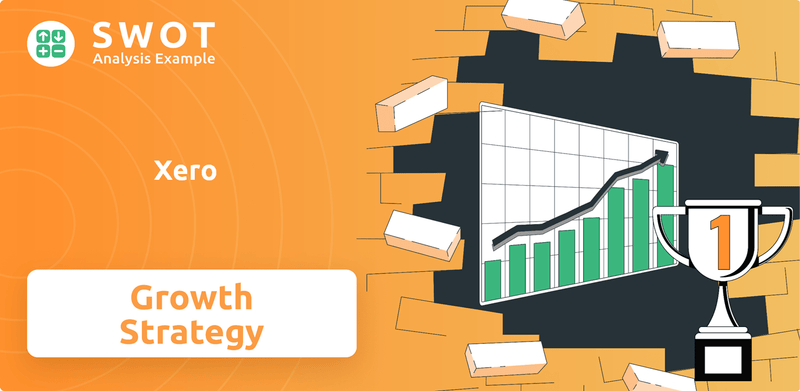
From its New Zealand roots, Xero's journey showcases the power of innovation in business accounting. This Xero company analysis will examine Xero's market share growth and expansion plans. We'll explore its revenue model and growth drivers, providing insights into the future of cloud accounting with Xero and its long-term growth potential.
How Is Xero Expanding Its Reach?
The expansion initiatives of Xero, a key player in the cloud accounting software market, are multifaceted, focusing on market penetration, geographical expansion, and continuous product enhancement. The company's strategy is designed to capitalize on the growing demand for financial technology solutions among small and medium-sized businesses globally. This approach includes tailoring its platform to meet the specific needs of different countries, ensuring localized compliance, and enhancing user experience to drive growth.
Xero's approach to growth is underpinned by a commitment to innovation and strategic partnerships. By continuously evolving its product offerings and integrating with third-party applications, Xero aims to provide a comprehensive solution for its users. Strategic alliances with financial institutions and technology providers are also crucial, enabling Xero to extend its reach and offer a more integrated suite of services. The company's focus on increasing average revenue per user (ARPU) indicates a strategy to offer more value-added services and premium features.
The company's strategy is designed to capitalize on the growing demand for financial technology solutions among small and medium-sized businesses globally. This approach includes tailoring its platform to meet the specific needs of different countries, ensuring localized compliance, and enhancing user experience to drive growth. Xero's growth strategy is also influenced by its subscription pricing model, which is designed to attract and retain customers while maximizing revenue potential. For a deeper understanding, explore the Mission, Vision & Core Values of Xero.
Xero continues to focus on deepening its presence in key markets like the UK, Australia, and New Zealand. This involves increasing market share by attracting more small businesses to use its cloud accounting software. The emphasis is on offering localized solutions that meet specific regulatory requirements and business practices, enhancing user adoption and retention.
Xero is actively expanding into new regions, with a particular focus on North America and other emerging markets. The strategy includes adapting the platform to meet the specific needs of these markets. This expansion is supported by strategic partnerships and localized marketing efforts to increase brand awareness and customer acquisition.
Xero continuously enhances its core accounting features and introduces new tools tailored to specific industries. This includes expanding its payment services and integrating with more e-commerce platforms. The company is also focused on improving analytics and reporting capabilities to provide users with more insightful financial data.
Strategic partnerships with banks, financial institutions, and other technology providers are crucial for Xero's expansion. These collaborations allow Xero to reach a wider customer base and offer a more integrated suite of services. Partnerships also enhance the platform's capabilities and provide users with access to a broader range of financial tools.
Xero's future prospects are promising, driven by its strategic focus on market expansion, product innovation, and strategic partnerships. The company's ability to adapt to changing market conditions and customer needs will be critical to its long-term growth. Xero's commitment to providing a comprehensive cloud accounting solution positions it well to capitalize on the growing demand for fintech solutions.
- Market Expansion: Continuing to penetrate existing markets and expand into new regions.
- Product Innovation: Enhancing core features and introducing new tools to meet industry-specific needs.
- Strategic Partnerships: Collaborating with banks and other providers to expand reach and service offerings.
- Subscription Model: Xero's subscription model allows for predictable revenue streams, supporting sustainable growth.
Xero SWOT Analysis
- Complete SWOT Breakdown
- Fully Customizable
- Editable in Excel & Word
- Professional Formatting
- Investor-Ready Format
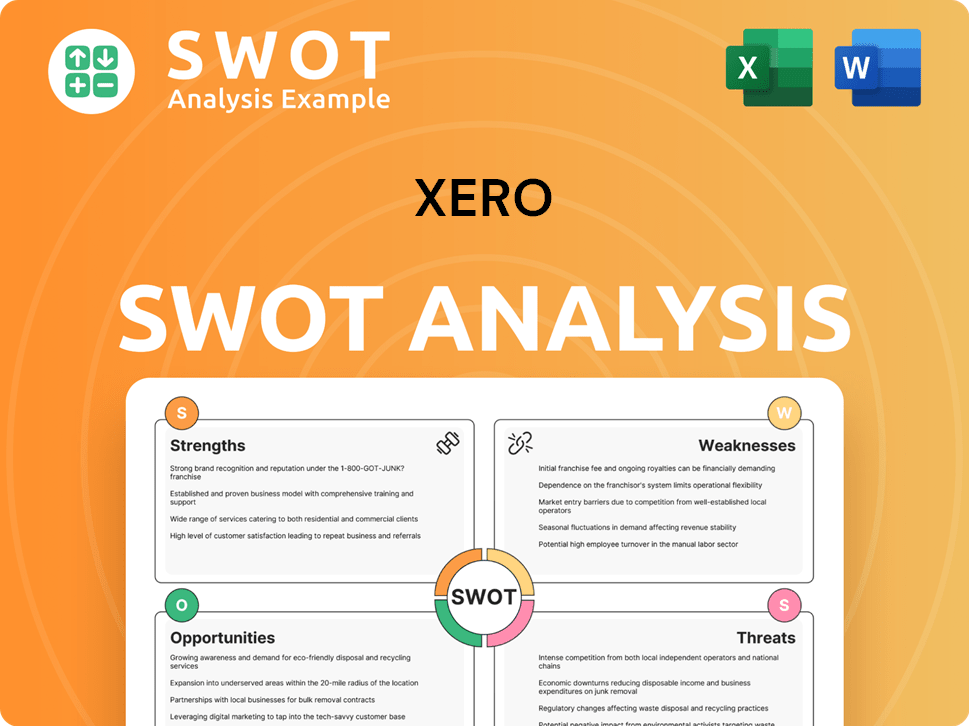
How Does Xero Invest in Innovation?
The innovation and technology strategy of the company is crucial for its continued growth. It heavily relies on using advanced technologies to improve its platform and user experience. This approach is a key part of the company's plan for the future.
The company consistently invests in research and development (R&D) to enhance its cloud-based accounting software. This ongoing investment helps the company stay competitive and provide better services. The focus on technological advancements is a core element of its strategy.
A major focus is on artificial intelligence (AI) and machine learning (ML) to automate tasks and provide insights for small businesses. This includes features like automated bank reconciliation and AI-powered financial forecasting. This commitment to technology is a key part of the company's approach to the market.
The company leverages AI and ML to automate routine tasks. This includes features like automated bank reconciliation and intelligent categorization of transactions. These features aim to improve data accuracy and provide predictive insights, enhancing the user experience.
The company prioritizes digital transformation within its platform. This involves continuous improvements to its user interface and mobile applications. The goal is to create a seamless and intuitive user experience for its customers.
The company's commitment to open APIs fosters a vibrant ecosystem of third-party applications. This allows businesses to customize their accounting solutions. This open approach helps the company integrate with other business tools.
The company uses data analytics to provide businesses with deeper insights into their financial performance. This helps them identify opportunities for growth. This focus on data-driven insights is a key part of the company's strategy.
The company consistently rolls out updates and new features. This demonstrates its ongoing commitment to technological leadership in the cloud accounting space. These updates are a key part of its strategy.
The company emphasizes a seamless and intuitive user experience. This is achieved through continuous improvements to the user interface and mobile applications. This focus is crucial for user satisfaction and retention.
The company's approach to technology is designed to support its overall Xero growth strategy and secure its Xero future prospects. It's a key aspect of the Xero company analysis. The company's focus on innovation and technology is expected to drive its long-term growth potential. For more insights, consider reading about the Marketing Strategy of Xero.
The company's technology roadmap includes advancements in AI and ML to automate tasks and provide predictive insights, enhancing the capabilities of its cloud accounting software. The company also focuses on improving its user interface, mobile applications, and integration capabilities with other business tools. These efforts support its business accounting solutions.
- Automated Bank Reconciliation: AI-driven automation for matching transactions.
- Intelligent Categorization: ML algorithms to classify transactions accurately.
- AI-Powered Forecasting: Predictive analytics for financial planning.
- Open APIs: Facilitating integration with third-party applications.
Xero PESTLE Analysis
- Covers All 6 PESTLE Categories
- No Research Needed – Save Hours of Work
- Built by Experts, Trusted by Consultants
- Instant Download, Ready to Use
- 100% Editable, Fully Customizable
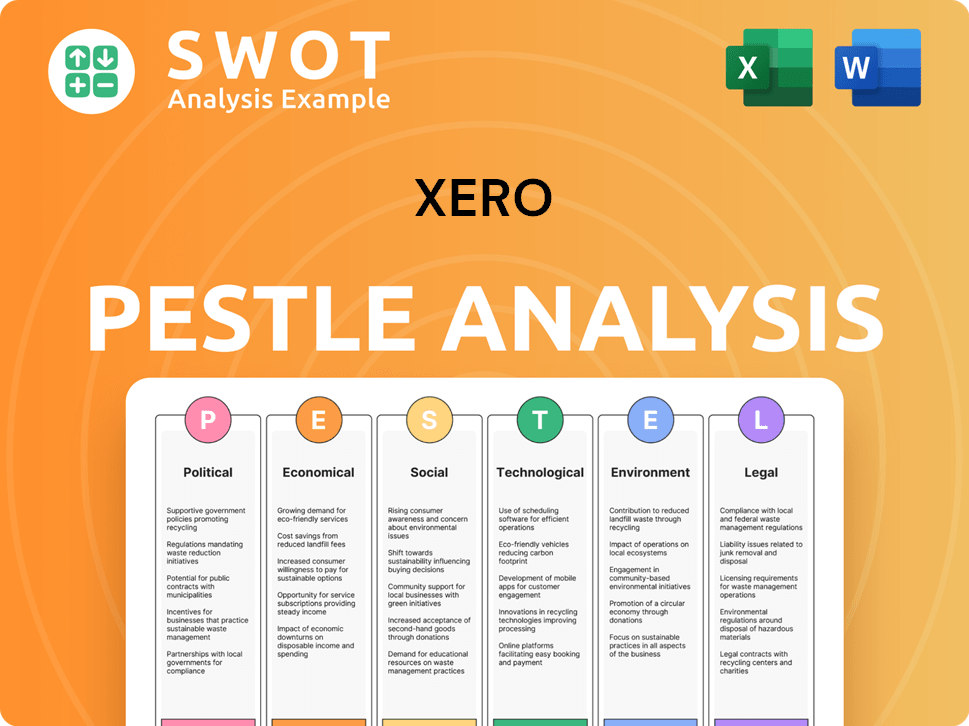
What Is Xero’s Growth Forecast?
The financial outlook for Xero is closely tied to its ambitious Xero growth strategy, which focuses on sustained revenue growth and improved profitability. The company's performance in FY24, with a 21% increase in revenue to NZ$1.65 billion, demonstrates strong top-line growth. This growth is a key indicator of the success of its strategic initiatives and its ability to capture market share in the cloud accounting software space.
A significant achievement for the company was its first full-year net profit of NZ$33.4 million, a considerable improvement from a net loss in FY23. This shift to profitability signals a successful execution of its strategy to balance growth with financial discipline. Furthermore, the company's focus on enhancing free cash flow, which reached NZ$212.7 million in FY24, up from NZ$103.3 million in FY23, provides a solid foundation for future investments and expansion.
Looking at the Xero future prospects, the company anticipates continued subscriber growth, particularly in its international markets. The company is also focused on increasing its average revenue per user (ARPU) through new value-added services and pricing adjustments. The company's strong financial position allows for continued investment in R&D and strategic expansion initiatives. For a deeper understanding of their target demographic, consider exploring the Target Market of Xero.
In FY24, the company reported a 21% increase in revenue, reaching NZ$1.65 billion. This growth highlights the company's ability to expand its market presence and attract new customers. The revenue growth is a key indicator of the company's overall success in the financial technology market.
The company achieved its first full-year net profit of NZ$33.4 million in FY24, a significant improvement from the previous year's loss. This shift to profitability is a direct result of its strategic initiatives and operational efficiencies. This is a major step forward for the company.
Free cash flow reached NZ$212.7 million in FY24, up from NZ$103.3 million in FY23. This increase demonstrates the company's ability to generate cash, which supports its investments in R&D and expansion. This financial strength allows for strategic growth initiatives.
The company anticipates continued subscriber growth, especially in international markets. This growth is driven by the ongoing digital transformation of small businesses globally. Expansion into new markets is a key component of the company's strategy.
The company's revenue growth and subscriber additions indicate increasing market share. The company's success in attracting and retaining customers is a key factor in its overall performance. This expansion is a testament to the company's strong market position.
The company's focus on small businesses drives its growth. The company offers solutions tailored to the needs of small businesses, driving adoption. This focus is a key driver of its long-term growth potential.
The company's subscription-based model drives recurring revenue. New features and services contribute to ARPU growth and revenue expansion. This model supports sustainable growth and profitability.
The company is at the forefront of cloud accounting innovation. Its technology roadmap includes continuous development and improvement. The company's commitment to innovation will drive its long-term success.
The company's strong brand and customer base provide a competitive edge. Its partnerships and integrations enhance its value proposition. These advantages support its market leadership.
The company is expanding its global presence. The company is focused on localized offerings to attract international customers. This global strategy is a key driver of its growth.
Xero Business Model Canvas
- Complete 9-Block Business Model Canvas
- Effortlessly Communicate Your Business Strategy
- Investor-Ready BMC Format
- 100% Editable and Customizable
- Clear and Structured Layout
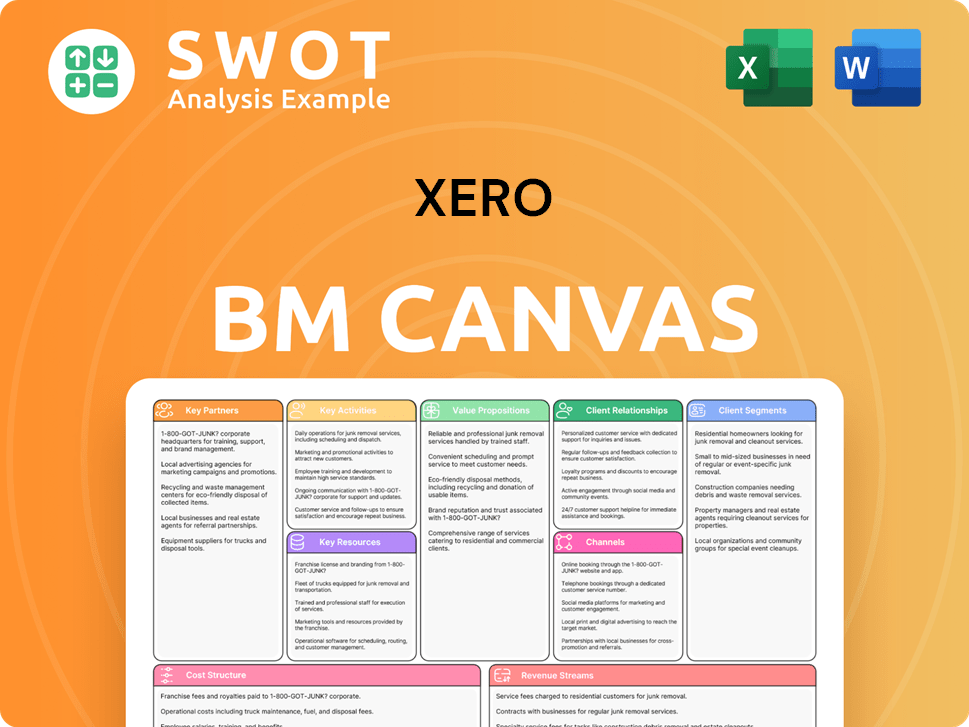
What Risks Could Slow Xero’s Growth?
Analyzing the potential risks and obstacles is crucial for a comprehensive Xero company analysis. While the company demonstrates a robust Xero growth strategy, several challenges could impact its future. Understanding these potential pitfalls is essential for investors and stakeholders evaluating Xero future prospects.
Market competition represents a significant risk. Established players and emerging startups continually strive for market share in the cloud accounting software sector, potentially leading to pricing pressures and a need for constant innovation. Regulatory changes, particularly concerning data privacy, taxation, and financial reporting across different countries, also pose ongoing challenges.
Technological disruption is another key concern. The rapid advancement of technologies like AI and blockchain demands continuous investment in research and development to maintain a competitive edge. Internal resource constraints, such as attracting and retaining top talent, could also hinder the company's growth plans. These factors necessitate proactive risk management and strategic adaptation.
The cloud accounting market is highly competitive, with major players like Intuit (QuickBooks) and Sage, along with numerous startups. This competition can lead to price wars and increased marketing expenses. The ability to differentiate through features and customer service is crucial for retaining and attracting customers.
Changes in data privacy regulations (like GDPR and CCPA), tax laws, and financial reporting standards across different countries pose risks. Compliance requires continuous platform updates and adaptation to local requirements. Failure to comply can lead to significant fines and reputational damage.
The rapid evolution of technologies like AI and blockchain requires continuous investment in R&D. Integrating new technologies effectively and responding to shifts in customer preferences are vital for maintaining a competitive advantage. Failure to innovate can lead to obsolescence.
As a cloud-based platform, is vulnerable to cyberattacks and data breaches. Protecting customer data is paramount. Implementing robust cybersecurity measures, including regular audits and employee training, is essential to mitigate these risks. The cost of a data breach can be substantial.
Economic downturns can impact small businesses, leading to reduced spending on accounting software. Subscription revenue could be affected as businesses cut costs. Diversifying the customer base and offering flexible pricing models can help mitigate this risk.
Attracting and retaining skilled tech talent in a competitive landscape is crucial for innovation and growth. High employee turnover can disrupt development cycles and increase costs. Offering competitive salaries, benefits, and a positive work environment is essential.
To mitigate these risks, Xero employs several strategies. Ongoing market analysis helps the company understand competitive dynamics and customer needs. Robust risk management frameworks are in place to identify and address potential threats proactively. A commitment to agile development allows for quick adaptation to regulatory changes and technological advancements. For example, the company has been actively working with local accounting bodies to ensure compliance with evolving regulations. Continuous focus on cybersecurity and data protection is also paramount in mitigating risks associated with data breaches or system vulnerabilities. For more context, take a look at Brief History of Xero.
The cloud accounting market is highly competitive, with major players like Intuit (QuickBooks) and Sage. Smaller competitors and startups also pose a threat. Each company vies for market share, requiring continuous innovation and effective marketing strategies. This competitive environment can lead to pricing pressures and increased customer acquisition costs.
Regulatory changes in different countries, especially regarding data privacy (e.g., GDPR, CCPA), taxation, and financial reporting, demand constant adaptation. Compliance requires significant investment in platform updates and legal expertise. Failure to comply can result in substantial penalties and reputational damage, impacting Xero's future prospects.
The rapid evolution of technologies such as AI and blockchain presents both opportunities and risks. Xero must continuously invest in R&D to integrate these technologies effectively and maintain its competitive edge. Failure to adapt could lead to obsolescence and loss of market share. The company's technology roadmap is crucial.
Internal resource constraints, including attracting and retaining top tech talent, can hinder growth. Managing rapid expansion and maintaining high customer service standards also pose challenges. Effective operational management and strategic workforce planning are essential for sustained success, influencing Xero's market share growth.
Xero Porter's Five Forces Analysis
- Covers All 5 Competitive Forces in Detail
- Structured for Consultants, Students, and Founders
- 100% Editable in Microsoft Word & Excel
- Instant Digital Download – Use Immediately
- Compatible with Mac & PC – Fully Unlocked
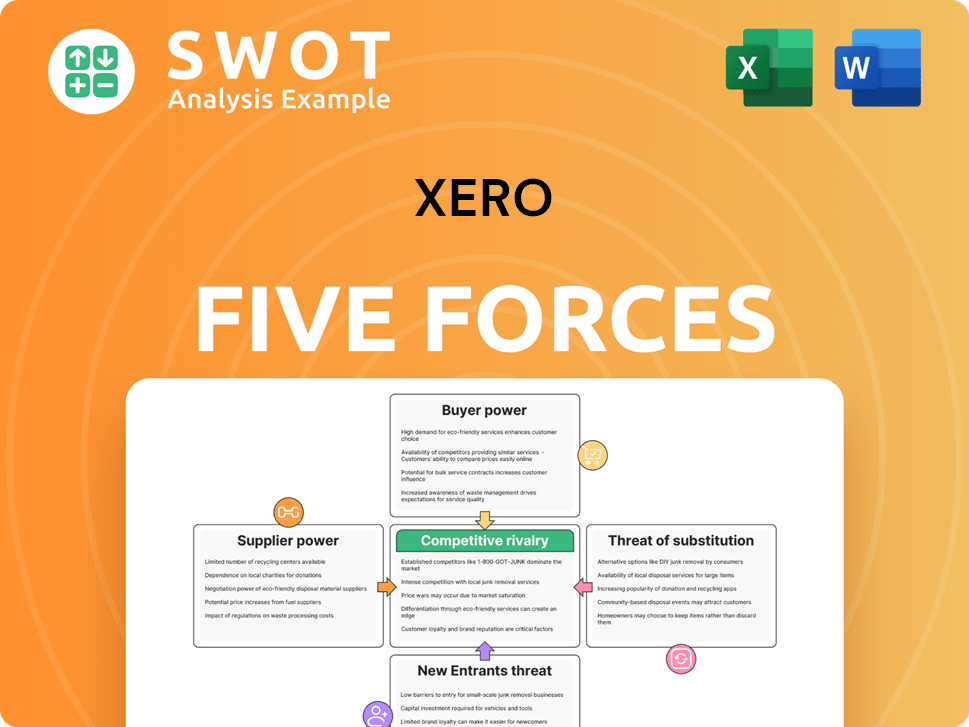
Related Blogs
- What are Mission Vision & Core Values of Xero Company?
- What is Competitive Landscape of Xero Company?
- How Does Xero Company Work?
- What is Sales and Marketing Strategy of Xero Company?
- What is Brief History of Xero Company?
- Who Owns Xero Company?
- What is Customer Demographics and Target Market of Xero Company?
Disclaimer
All information, articles, and product details provided on this website are for general informational and educational purposes only. We do not claim any ownership over, nor do we intend to infringe upon, any trademarks, copyrights, logos, brand names, or other intellectual property mentioned or depicted on this site. Such intellectual property remains the property of its respective owners, and any references here are made solely for identification or informational purposes, without implying any affiliation, endorsement, or partnership.
We make no representations or warranties, express or implied, regarding the accuracy, completeness, or suitability of any content or products presented. Nothing on this website should be construed as legal, tax, investment, financial, medical, or other professional advice. In addition, no part of this site—including articles or product references—constitutes a solicitation, recommendation, endorsement, advertisement, or offer to buy or sell any securities, franchises, or other financial instruments, particularly in jurisdictions where such activity would be unlawful.
All content is of a general nature and may not address the specific circumstances of any individual or entity. It is not a substitute for professional advice or services. Any actions you take based on the information provided here are strictly at your own risk. You accept full responsibility for any decisions or outcomes arising from your use of this website and agree to release us from any liability in connection with your use of, or reliance upon, the content or products found herein.